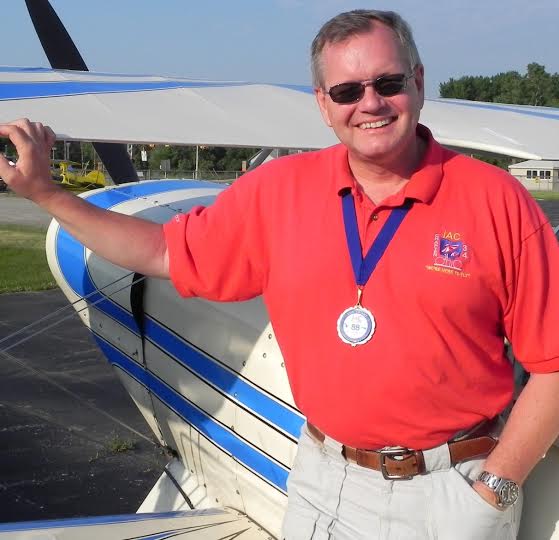Flying the 2023 Sportsman Sequence - Part 4 – Looping the Loop

WE DO LOVE THE loop, don’t we? In many ways it represents aerobatics. Seeing those first loops fired our imaginations and our yearning for all-attitude flight. Someday, we thought, that would be us. Later, though, we found it was much more difficult than we imagined to make it vertical, keep it round, and remain oriented. I am speaking about the loop mostly to new people, especially those who are coming to us with slick experimental airplanes, and those whose airplanes do not have inverted systems. I am also speaking to those in low-horsepower/high-drag airplanes, and to our new competitors.

The loop is a finesse thing, not a brute force thing, and done right it is not hard on the airplane. Also, the loop seems so simple, yet it beautifully illustrates the mental leaps made by the Wright brothers in the creation of controlled maneuvering flight.
To do a decent loop we must not just look over the nose and pull the elevator back until the ground reappears. (Bad dog! Bad dog!). Looking at nothing but blue sky for the first half of the loop gives no reference for control. This first half of the loop is where most people get their loops leaned over from vertical, and twisted off heading.
The main idea in aerobatics, nicely said by 1972 World Champion Charlie Hillard in the EAA video Getting Started in Aerobatics is “where to look and when.” Looking in the right place at the right time during each maneuver makes them all easier to fly. I highly recommend that EAA video for new people, with great instruction given by three-time U.S. National Champion Clint McHenry. Clint didn’t start competing in aerobatics until he had retired! You can’t be too old.

As we break down the loop into segments, we will talk heavily about where to look, and when. During most of the loop we will be looking along the left wingtip, not over the nose. Making pitch, roll, and yaw inputs
using a wingtip reference takes some getting used to. Controlling the wingtip in relation to the horizon in the first half of the loop is the key to staying oriented and keeping the loop vertical. We fly the loop in thirds, but we must analyze it in quarters. See figure 2. From the middle of Quarter 2 over the top to the middle of Quarter 3 is the hardest portion to fly as the airplane’s energy state is at its lowest.
The first third of the loop is the high-speed, high-g portion that includes all of Quarter 1 and the first half of Quarter 2. The middle third, and the part where most people get in trouble, is from the last half of
Quarter 2, up and over to the middle of Quarter 3. This is the low-speed, low-g portion of the loop. The last third is from the last half of Quarter 3 and all the way through Quarter 4. This is another highspeed,
high-g portion that is a mirror image of the first third. Yes, I know the thirds aren’t exactly equal, but they each have their own character, their own energy states, their own sight lines, and their own control challenges.
The first key, especially in a low-performance airplane, is to pull enough g’s to make the first third small enough. You must also be at or
above the handbook entry speed for the loop. It is very important to pull enough g’s in the first quarter, at least 3g’s, or you won’t have enough horsepower and leftover speed to get around a larger loop. In fact, if your energy state is low enough you may not even get over the top of the loop, falling out of the maneuver.
Learning tip: Because of that low energy state over the top of the loop, when you are new and learning the loop we do not want you to make it round. Make it a little taller than it is wide, spending very little time across the top. That will give you less time to get into trouble. This makes your loop a good old-fashioned “barnstormer’s” loop, which still looks good. Once you are proficient in these tall loops you can work at making them more round if you wish, which means spending more time in the low-energy area in the middle third. The barnstormer’s loop is also a good ride for a passenger.
Also, enter the loop fast. Think of book looping speeds as minimums: More is better. This is good advice in general for all maneuvers except for the snap-roll speeds, which are maximums.
Read the full article HERE
Articles in the "2023 Sportsman Sequence" Series
Flying the 2023 Sportsman Sequence by Gordon Penner, In the Loop January 2023
Flying the Wedge by Gordon Penner, In the Loop February 2023
Flying the Immelman, by Gordon Penner, In the Loop March 2023
Flying the Loop, by Gordon Penner, Sport Aerobatics December 2019
Flying the Half Cuban, by Gordon Penner
Flying the Humpty Bump, by Gordon Penner, In the Loop June 2023
Flying the Competition Roll, by Gordon Penner, In the Loop July 2023
Flying the Hammerhead, by Gordon Penner, In the Loop August 2023
Flying the Spin, by Gordon Penner, In the Loop September 2023
Flying the Aerobatic Turn, by Gordon Penner, In the Loop October 2023
Online Resources:
Introduction to Aresti, by Brian Howard, www.iac.org/aerobatic-figures
More articles on typical Sportsman category figures
Half Cubans, Accurate 45-degree downlines, by Giles Henderson, Sport Aerobatics June 2011, pg. 28
Aerobatic Trim Part 1, by Gordon Penner, Sport Aerobatics September 2020
Aerobatic Trim Part 2, by Gordon Penner, In the Loop October 2020

